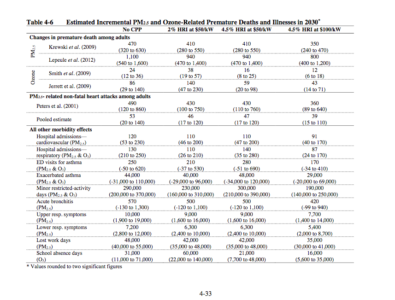Guest Blogger Nick Bryner: Cooking the Books While Cooking the Planet: A First Look at the EPA’s ACE Rule
Final Rule Changes Baseline Assumptions & Approach to Cost-Benefit Analysis in Attempt to Justify Weak Standards
Yesterday, the Trump EPA released its long-awaited response to the Obama-era Clean Power Plan. At first glance, the final rule has been carefully crafted in an attempt to avoid several glaring legal vulnerabilities of the rule—and to obscure the obvious inadequacy of the Administration’s response to climate change.
The EPA has found many contradictory ways to justify its action. For over two years, Administrators Pruitt and Wheeler, along with their boss, have decried the Clean Power Plan as a costly regulation that would damage the coal industry. Yet through the rule and the accompanying regulatory impact analysis (RIA) released yesterday, the EPA assumes that coal will decline significantly in the next decade, makes calculations to minimize the cost estimated for the Clean Power Plan, and incorporates additional assumptions (that EPA officials and other conservatives associated with the administration have disavowed) to stretch the economic value of the little the rule will do.
There is still a lot to digest in the rule, so I will only attempt to touch on a few issues, and leave it to others for additional analysis in the days and weeks to come.
Split repeal
The EPA splits its rule in three parts. First, it repeals of the Obama Administration’s Clean Power Plan, finalized in 2015. Second, it lays out a new rule, the Affordable Clean Energy (ACE) rule, that creates a weak, power plant-by-power plant regulatory scheme that calls for heat rate improvements (essentially, efficiency increases) as a way of decreasing GHG emissions. Third, it provides general rules about state implementation of the ACE rule and other rules based on Section 111(d) of the Clean Air Act.
The split is important because of how the Administration will likely defend the new rule in court. In 2016, the DC Circuit heard oral arguments on the validity of the Clean Power Plan, but never reached a decision, as the Trump Administration announced early in 2017 its intent to repeal the rule. The Administration will likely argue that in order to reinstate the Clean Power Plan as Obama’s EPA promulgated it, a court would have to both (a) find that the new rule is unlawful and (b) find that the EPA’s decision to repeal the 2015 Clean Power Plan was unlawful.
In order to make this case, the EPA has completely avoided making any cost- or policy-based argument about repealing the Clean Power Plan, and has instead exclusively argued that, on legal grounds, the EPA’s interpretation of the Clean Air Act required it to repeal the plan. (The argument focuses on whether the Clean Air Act’s term “best system of emission reduction” can include, as the Clean Power Plan did, consideration of actions within the electricity grid system as a whole, such as switching from coal to natural gas and/or renewable electricity generation.)
By separating the repeal from the new rule, the EPA has changed the game about how it presents the costs and benefits of its chosen approach. By Executive Order, the EPA provides a cost-benefit analysis associated with any major rule. In proposing the ACE rule, the EPA compared the economic costs and health benefits of its new rule to the Obama-era one—a comparison that highlighted how many more premature deaths and illnesses from air pollution would occur every year under the Trump plan.
Now, the EPA merely compares its nothingburger approach to a baseline of nothing. Table 4-5 from the RIA (page 150 of the PDF) shows an estimate of 50 to 122 avoided deaths from ozone and PM2.5 exposure in 2030 (depending on the study used). In the ACE proposal in 2018, EPA had estimated that its rule would cause an increase of as many as 1000 deaths per year from PM2.5 and ozone-related deaths, plus tens of thousands of asthma cases and lost workdays and school days to illness, when compared to the Clean Power Plan (see Table 4-6 from the proposal’s RIA).

By making the analysis only about the new rule, the EPA tries to bury its acknowledgment that the Clean Power Plan would have saved lives underneath its legal arguments.
Disappearing costs and disappearing benefits
The EPA has continued with its trend under the Trump Administration to distort climate policy costs and benefits beyond recognition. First, as under the initial proposal to repeal the Clean Power Plan issued by Administrator Pruitt in 2017, the EPA decided it would ignore all of the global costs of climate change, focusing exclusively on domestic costs instead. The EPA provides two alternatives—using a 3% or 7% discount rate—that result in a calculated domestic social cost of carbon as either $8 per ton in 2030 or $1 per ton, respectively (see Table 4-1 of the final rule’s RIA). In two steps—sticking our heads in the sand about climate-related damages outside the United States, and heavily discounting the interests of future generations—the financial imperative to deal with climate change nearly disappears.
All of this analysis makes it, ironically, more difficult to justify the EPA’s new rule. Imposing heat rate improvement requirements will cost money, and reduced estimates of the cost of climate change call those investments into question. As a result, EPA’s bottom-line cost-benefit analysis still relies on co-benefits (that is, benefits from reducing pollutants other than GHGs, which are targeted directly by the regulation) to indicate that the rule will generate net estimated benefits.
Bizarrely, the EPA now concludes that the ACE rule will be far more expensive to implement by 2030 than the original Clean Power Plan. Because the EPA’s baseline has shifted significantly, the agency now assumes that the Clean Power Plan standards will already be met by 2030, even without the rule in place. Complying with the Clean Power Plan, the EPA says, would only cost $0.2 million in 2030 if a national trading program were available (see Table 2-6 of the RIA).
Compliance costs for ACE are projected at $280 million in 2030 (Table 6-1). At the end of the day, it may not be much nationwide, but it’s an interesting price tag for a policy that seems to be intended only as a legal defense maneuver.
Nicholas Bryner is an Assistant Professor of Law at Louisiana State University. Professor Bryner was an Emmett/Frankel Fellow in Environmental Law and Policy at UCLA School of Law from 2016 to 2018.







Reader Comments